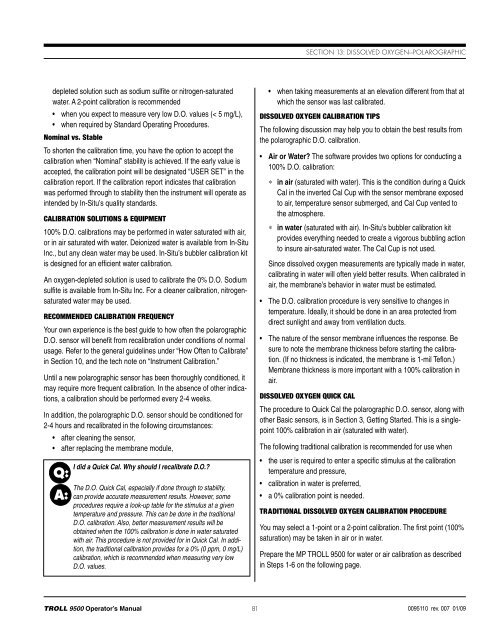TROLL 9500 Operator's Manual - Geotech Environmental Equipment
TROLL 9500 Operator's Manual - Geotech Environmental Equipment
TROLL 9500 Operator's Manual - Geotech Environmental Equipment
You also want an ePaper? Increase the reach of your titles
YUMPU automatically turns print PDFs into web optimized ePapers that Google loves.
Section 13: Dissolved Oxygen—Polarographicdepleted solution such as sodium sulfite or nitrogen-saturatedwater. A 2-point calibration is recommended• when you expect to measure very low D.O. values (< 5 mg/L),• when required by Standard Operating Procedures.Nominal vs. StableTo shorten the calibration time, you have the option to accept thecalibration when “Nominal” stability is achieved. If the early value isaccepted, the calibration point will be designated “USER SET” in thecalibration report. If the calibration report indicates that calibrationwas performed through to stability then the instrument will operate asintended by In-Situ’s quality standards.Calibration Solutions & <strong>Equipment</strong>100% D.O. calibrations may be performed in water saturated with air,or in air saturated with water. Deionized water is available from In-SituInc., but any clean water may be used. In-Situ’s bubbler calibration kitis designed for an efficient water calibration.An oxygen-depleted solution is used to calibrate the 0% D.O. Sodiumsulfite is available from In-Situ Inc. For a cleaner calibration, nitrogensaturatedwater may be used.Recommended Calibration FrequencyYour own experience is the best guide to how often the polarographicD.O. sensor will benefit from recalibration under conditions of normalusage. Refer to the general guidelines under “How Often to Calibrate”in Section 10, and the tech note on “Instrument Calibration.”Until a new polarographic sensor has been thoroughly conditioned, itmay require more frequent calibration. In the absence of other indications,a calibration should be performed every 2-4 weeks.In addition, the polarographic D.O. sensor should be conditioned for2-4 hours and recalibrated in the following circumstances:• after cleaning the sensor,• after replacing the membrane module,Q:A:I did a Quick Cal. Why should I recalibrate D.O.?The D.O. Quick Cal, especially if done through to stability,can provide accurate measurement results. However, someprocedures require a look-up table for the stimulus at a giventemperature and pressure. This can be done in the traditionalD.O. calibration. Also, better measurement results will beobtained when the 100% calibration is done in water saturatedwith air. This procedure is not provided for in Quick Cal. In addition,the traditional calibration provides for a 0% (0 ppm, 0 mg/L)calibration, which is recommended when measuring very lowD.O. values.• when taking measurements at an elevation different from that atwhich the sensor was last calibrated.Dissolved Oxygen Calibration TipsThe following discussion may help you to obtain the best results fromthe polarographic D.O. calibration.• Air or Water? The software provides two options for conducting a100% D.O. calibration:∗ in air (saturated with water). This is the condition during a QuickCal in the inverted Cal Cup with the sensor membrane exposedto air, temperature sensor submerged, and Cal Cup vented tothe atmosphere.∗ in water (saturated with air). In-Situ’s bubbler calibration kitprovides everything needed to create a vigorous bubbling actionto insure air-saturated water. The Cal Cup is not used.Since dissolved oxygen measurements are typically made in water,calibrating in water will often yield better results. When calibrated inair, the membrane’s behavior in water must be estimated.• The D.O. calibration procedure is very sensitive to changes intemperature. Ideally, it should be done in an area protected fromdirect sunlight and away from ventilation ducts.• The nature of the sensor membrane influences the response. Besure to note the membrane thickness before starting the calibration.(If no thickness is indicated, the membrane is 1-mil Teflon.)Membrane thickness is more important with a 100% calibration inair.Dissolved Oxygen Quick CalThe procedure to Quick Cal the polarographic D.O. sensor, along withother Basic sensors, is in Section 3, Getting Started. This is a singlepoint100% calibration in air (saturated with water).The following traditional calibration is recommended for use when• the user is required to enter a specific stimulus at the calibrationtemperature and pressure,• calibration in water is preferred,• a 0% calibration point is needed.Traditional Dissolved Oxygen Calibration ProcedureYou may select a 1-point or a 2-point calibration. The first point (100%saturation) may be taken in air or in water.Prepare the MP <strong>TROLL</strong> <strong>9500</strong> for water or air calibration as describedin Steps 1-6 on the following page.<strong>TROLL</strong> <strong>9500</strong> Operator’s <strong>Manual</strong> 810095110 rev. 007 01/09
















